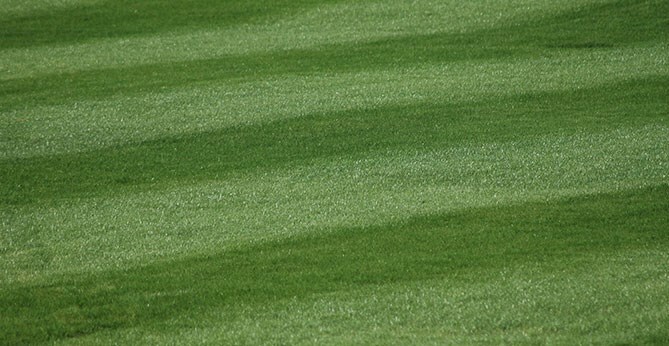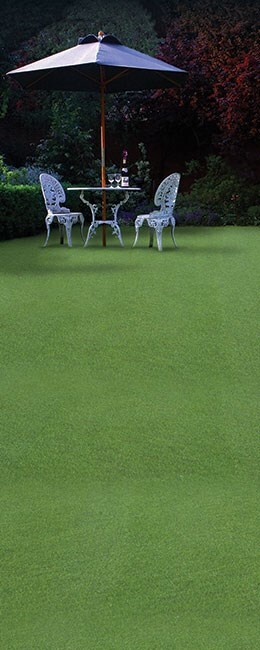
How to make a new lawn
The lawn is a key component in most gardens; providing the link between the garden’s different
elements - a calming sea of green between flamboyant borders and other attention-seeking
features. A lawn opens up the garden, thus guiding the eye and creating vistas, as well as setting
the tone of the overall design. A lawn is also the quickest and easiest way of filling a new garden
from scratch. You don’t need to worry about the final shape, since beds and borders and other
features can be cut out and added later. See my ‘Making a new flower bed’ to show you how.
A new lawn can be created by sowing seed or laying turf. Both can be carried out at any time
during the growing season, but late spring and early autumn are best times when the soil is
relatively moist and warm. This will encourage quick establishment and an even-textured result.
If you make a new lawn in spring, make sure you are able to keep it well watered during the first
few months.
New lawn from turf
- Instant impact
- Can be laid spring to autumn except when frosty, or when ground is muddy
- Must be laid within two days of delivery
- More expensive
New lawn from seed
- Much cheaper option
- Takes several months to establish
- Can be sown April to September except when ground is muddy or bone dry
Designing a new lawn
The size and shape of a lawn can have a big influence on the garden’s overall design. However, bear in mind how easy it will be to mow, before creating very intricate shapes with tight corners and lots of edges to keep in trim. The most successful lawns are usually very simple shapes that are easy to look after - sweeping curves means the mower can be run around the edges without stopping and starting. Also avoid unnecessary obstacles, such as island beds, which will make looking after the lawn more time consuming. For this reason, if there are existing trees, try to incorporate them into borders rather than setting them in the lawn. To help visualise what a new lawn might look like in a garden, lay out a garden hose to form the outline. Check how it looks from the most important viewing points, such as the patio or kitchen window, then move the hose around, changing the shape and size until a pleasing result is achieved. Finally, you need to decide whether you require an ornamental sword or hard-wearing family lawn because you will need to select the right turf or seed mixture.

Deciding to use grass seed or turf?
Laying turf has become the most popular method for creating a new lawn from scratch. It instantly transforms a garden and laying turf looks a lot easier than preparing a large seedbed to sow seed. In fact, it is just as important to prepare the ground thoroughly when laying turf, because any lumps or hollows are much more difficult to correct later. Furthermore, heaving the rolled-up turves around the garden can be a lot of hard work – especially if the new lawn is large or access is awkward. Turf can be put down anytime throughout the growing season, but needs to be laid straightaway after delivery - so careful planning is required. Grass seed, on the other hand, is cheaper and easier to use (especially for intricate shapes), but takes months to look good, requires netting from birds and weeding until the grasses provide complete leaf-cover. Both turf and seed require regular watering until established.
Preparing the site
There are four basic steps to good site preparation whether you are making a new lawn from seed or turf.
- Clear the site and dig it thoroughly, removing any weeds, large stones and other debris as you go.
- Roughly rake the soil level, removing any stones that come to the surface and leave to settle.
- Tread the area thoroughly, taking tiny steps with the weight on your heels to remove any air pockets and to create a firm base.
- Carefully rake level once more until it is flat and even right across the area.

Laying turf
Lay turf straight away after delivery to prevent it deteriorating. If there is a straight edge to the lawn, lay the first row of turves along the edge and butt them close together leaving no gaps. Standing on short planks on the laid turf, lay subsequent rows with the joints staggered like bricks in a wall. The planks will help spread your weight and press the turf flat, so that it is in good contact with the soil below. Damaged turves and any that are unusually thick or thin are best used for the edges. Carefully move the planks forward as each row is completed and repeat this process until the whole lawn has been laid. Where possible, leave turves overhanging the edges and let them root before trimming to size, using a special turf cutter or sharp spade. This will prevent the edges drying out and ensure they establish as quickly as the rest of the lawn. Give it a good drink after laying and water regularly and thoroughly during dry weather until the lawn is well established. Do not use the lawn for at least a month.
Sowing seed
Scatter a general fertiliser on impoverished soils and carefully rake into the surface layer. Divide the area up into 1m-wide strips using garden lines, then use canes to subdivide the strip into 1m squares. Then measure out sufficient seed for that area using a polystyrene cup. Mark the level on the cup and then cut it down to form an accurate scoop to measure the correct amount of seed for each subsequent square-metre. For the most accurate distribution of seed, scatter half of a scoop in one direction over the entire square meter and the other half over the same area but at right angles to the first scattering. Repeat the process until the whole lawn area has been seeded. Lightly rake the surface to incorporate the seed into the surface and hide it from birds. Protect the seedbed using bird-proof netting and water thoroughly if it doesn’t rain. Do not use the lawn for at least three months.
Aftercare
Start cutting new lawns once the grass is about 5cm long. Set the mower-blades high and trim off the tips for the first cut. Do not cut shorter than 2-3cm until the lawn has thickened up and the joints between turves have disappeared.
